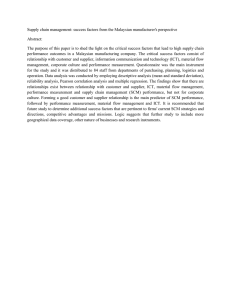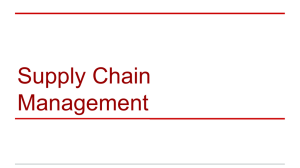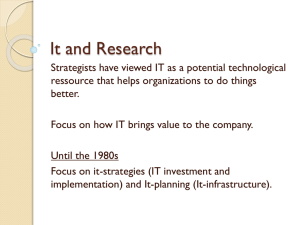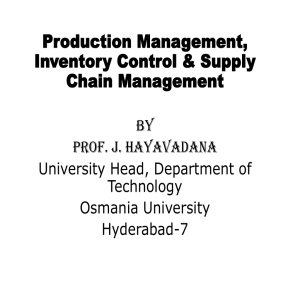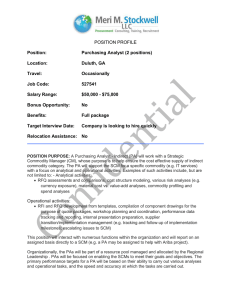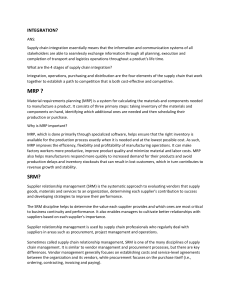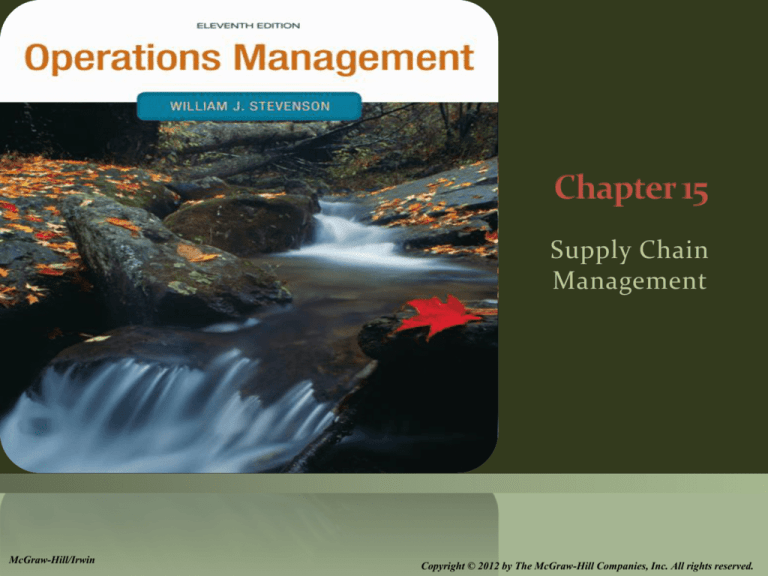
Supply Chain
Management
McGraw-Hill/Irwin
Copyright © 2012 by The McGraw-Hill Companies, Inc. All rights reserved.
You should be able to:
1.
Discuss the key issues of supply chain management (SCM)
2. Name the recent trends in SCM
3. Summarize the motivations and risks of outsourcing as a
strategy
4. State some of the complexities that are involved with global
supply chains
5. List some of the strategic, tactical and operational
responsibilities of SCM
6. Give examples of some advantages of e-business
7. Explain the importance of supplier partnerships
8. Discuss the issues involved in managing returns
9. List the requirements of an effective supply chain
10. Name some of the challenges in creating an effective supply
chain
Student Slides
15-2
Supply Chain:
the sequence (or network) of organizations - their
facilities, functions, and activities - that are involved in
producing and delivering a product or service
Sometimes referred to as value chains
Student Slides
15-3
The sequence of the supply chain begins with basic
(primary materials) suppliers and extends all the way to
the final customer, involving the following business
entities
Warehouses
Factories
Processing centers
Distribution centers
Retail outlets
Offices
Student Slides
15-4
Supply chain functions and activities
Forecasting
Purchasing
Inventory management
Information management
Quality assurance
Scheduling
Production and delivery
Customer service
Student Slides
15-5
Supply Chain Management (SCM)
The strategic coordination of business functions within
a business organization and throughout its supply
chain for the purpose of integrating supply and
demand management
Student Slides
15-6
The goal of SCM is to match supply to demand as
effectively and efficiently as possible
Key issues:
Determining appropriate levels of outsourcing
Managing procurement
Managing suppliers
Managing customer relationships
Being able to quickly identify problems and respond to
them
Managing risk
Student Slides
15-7
Trends affecting supply chain design and
management:
Measuring supply chain ROI
“Greening” the supply chain
Re-evaluating outsourcing
Integrating IT
Managing risks
Adopting lean principles
Student Slides
15-8
The purchasing department is responsible for
obtaining the materials, parts, and supplies and
services needed to produce a product or provide a
service.
The goal of procurement
Develop and implement purchasing plans for products
and services that support operations strategies
Student Slides
15-9
E-business
The use of electronic technology to facilitate business
transactions
Applications include
Internet buying and selling
E-mail
Order and shipment tracking
Electronic data interchange
Product and service promotion
Provide information about products and services
Student Slides
15-10
Choosing suppliers
Supplier audits
Supplier certification
Supplier relationship management
Supplier partnerships
CPFR (collaborative planning, forecasting, and
replenishment)
Strategic partnering
Student Slides
15-11
Variations in demand cause inventory fluctuations to
fluctuate and get out of control
Inventory fluctuation can be magnified by
Periodic ordering
Reactions to shortages
Forecast inaccuracies
Order batching
Sales incentives and promotions
Liberal product return policies
Results in
Higher costs
Lower customer satisfaction
Student Slides
15-12
Logistics
Refers to the movement of materials, services,
cash, and information in a supply chain
Movements within a facility
Incoming shipments
Outgoing shipments
Student Slides
15-13
It begins with strategic sourcing
Analyzing the procurement process to lower costs by
reducing waste and non-value-added activities,
increase profits, reduce risks, and improve supplier
performance
There must be
Trust
Effective communication
Information velocity
Supply chain visibility
Event management capability
Performance metrics
Student Slides
15-14
Effective supply chains are necessary for
organizational success
Requires integration of all aspects of the chain
Supplier relationships are a critical component
of supply chain strategy
Lean operations and six sigma are being
employed to improve supply chain success
Student Slides
15-15

